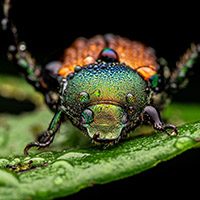Video: Tips and techniques to capture amazing macro photos right in your backyard
posted Tuesday, August 23, 2022 at 1:00 PM EDT

OM Ambassador Chris McGinnis presented at B&H Optic this year, emphasizing how many amazing photo opportunities you can find in your local area, especially if you have a macro lens. While traveling to capture stunning, exotic locations is amazing, it's an expensive endeavor and not possible for everyone. Fortunately, you don't even need to leave your hometown to make amazing photos. In the presentation below, "Backyard Macro: Travel to a New World," McGinnis shows how it's possible to photograph interesting subjects using a macro lens and flash either in your yard or a local park.
Everything in McGinnis's presentation was shot in his yard, and he discusses the gear and techniques he used to make the images. While McGinnis discusses the precise gear he uses, like an OM-1 camera and Olympus M.Zuiko 60mm F2.8 Macro and Olympus M.Zuiko 40-150mm F2.8 PRO lenses, it's more about the type of gear he uses. Just about any camera will do, and you'll want a lens that has good close-focusing performance. You will also want to use a flash, which can be on-camera or off-camera. To ensure nice light, you may also need to use a diffuser. While you can use natural light, a flash and diffuser deliver consistently great results no matter the available light.
Sometimes, the background is a bit distracting, and you can't exactly tell insects where to position themselves. However, by using flash, it's possible to isolate the subject and capture a stunning photo with a black background. You don't need to use an actual backdrop to do this. You can adjust your camera and flash settings to achieve the look. McGinnis outlines this technique about halfway through the above video.
In terms of general camera settings, every situation is a bit different, but McGinnis starts in manual mode with a 1/100s shutter speed and F8 aperture. His OM-1's base ISO is 200, so your settings may differ. He manually focuses much of the time and often uses in-camera stabilization to help ensure sharp images. McGinnis sometimes uses focus bracketing and stacking techniques to increase the depth of field without needing to stop the lens all the way down, which would result in diffraction and soft results. Sometimes even stopping down isn't enough if you're very close to your subject. Focus bracketing is when you shoot sequential images at different focus distances. You can achieve this with focusing rails, special in-camera modes, or manually selecting different focus points. Special software – or perhaps even your camera itself – can then combine the focus bracket images into a single composite image with an expanded depth of field.
In addition to showing off beautiful macro photos, McGinnis wraps up the video with his top 10 tips for macro photography. There's no one-size-fits-all approach, but there are some general tips that will help you be more successful. You must be patient, approach your subjects very slowly, and try to get as low as possible. To see the other seven tips, watch the full presentation.
To see more from Chris McGinnis, visit his website and follow him on Instagram. His macro photography is stellar, so I highly recommend checking them out. To see more videos from B&H, visit YouTube.
(Via B&H)